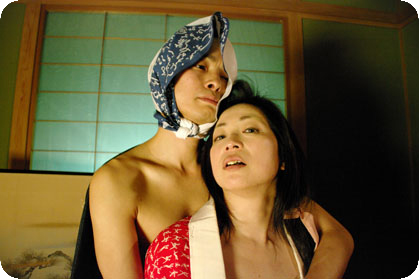Life is comedy , if you look from a distance.
This film is Watanabe Mamoru last gift.
This film is Watanabe Mamoru last gift.
【Pink Film】
 The term "Pink Film" (pinku eiga) refers to the fifty year old industry of low-budget Japanese adult cinema. Named after a "Pink"color that is strongly associated with adult or erotic material in Japan, Pink Films are typically identified by their production costs—about three million yen (roughly U.S. $30,000)—and by the fact that they include a number of sex scenes.
The term "Pink Film" (pinku eiga) refers to the fifty year old industry of low-budget Japanese adult cinema. Named after a "Pink"color that is strongly associated with adult or erotic material in Japan, Pink Films are typically identified by their production costs—about three million yen (roughly U.S. $30,000)—and by the fact that they include a number of sex scenes.The first title to be called a Pink Film was director Kobayashi Satoru's 1962 feature, Market of Flesh (Nikutai no ichiba). After Kobayashi's film was released, Pink Films began to play in small and medium-sized cinemas throughout Japan. With screening fees that were much lower than that of major studio features and promising the spectacle of nude bodies on screen, Pink Films appealed to theater managers and audiences around the country. In 1965, the year Watanabe Mamoru directed his first feature, over 200 Pink Films were produced.
In the early years, Pink Film provided an ideal opportunity for assistant directors of TV movies or educational films to advance to directing theatrical features. One person who benefited from this system was Wakamatsu Koji, who directed his first Pink Film Sweet Trap (Amai wana) in 1963 and continued to make scandalous movies about sex and terrorism throughout the decade. Wakamatsu's films were enthusiastically supported by young people who were active in the student movement of the time. As time passed,the mass media (which had almost completely ignored Pink Film) gradually began to report on the industry as well.
After the 1970s, when the majorstudios stopped training directors and assistant directors, Pink Film remained an effective way for aspiring filmmakers to learn the craft. The Pink Film industry prepared many talented directors for successful careers in mainstream cinema. Those include Takahashi Banmei, Izutsu Kazuyuki, Takita Yojiro (director of the Academy Award-winning Departures), Suo Masayuki (director of Shall We Dance?), Zeze Takahisa, and many others.
Today, the number of Pink Film releases (and specialty adult theaters to screen them in) is rapidly declining in Japan, but this theatrical adult filmindustry is still active. As a high-quality, cinematic, and filmic alternative to adult video, and as the last existing form of the program picture in Japan,Pink Film continues to energize and invigorate Japanese cinema. Pink Films of the last half-century have played an underappreciated—but absolutely indispensable—role in the history of Japanese cinema.
【A PG & PINK-LINK Production: A Film Commemorating the 50th Anniversary of Pink Film】
In 1980, a group of enthusiastic fans organized the first ever Pink Film festival in Japan—the Zoom Up Film Festival. At this inaugural event, the first ever Pink Film director's award was given to Takahashi Banmei, and the best film award was given to Virgin Rope Makeover (Shojo nawa gesho), directed by Watanabe Mamoru.Today, two groups continue in this tradition of active audience support for Pink Films and filmmakers—PG and PINK-LINK. PG, led by Hayashida Yoshiyuki, has been active for 25 years in Japan's eastern Kanto region. PG continues to publish a Pink Film mini-magazine and organize a yearly festival known as the Pink Taisho (essentially the Academy Awards of the Pink Film industry). PINK-LINK, led by Ota Kounki, has been active in the Kansai region for 15 years and publishes a monthly free magazine with Pink Film release information, screening schedules, and commentary.
In 2011, Hayashida and Ota began to collaborate on the production of a feature film that would commemorate the fifty year history of Pink Film. They found the ideal source material in a script that Watanabe Mamoru was planning to direct as Treasure Ship: Latitudes of Lust.
Hayashida and Ota approached existing distributors and production companies with their proposal, but with the Pink industry in such a precarious financial position, they were not able to secure support. As a result, in 2013 Hayashida and Ota decided to produce and distribute Treasure Ship: Latitudes of Lust completely independently, essentially returning to the very roots of Pink Film production.
【The Pink Film Treasure Ship: Latitudes of Lust】
 With its comedic story about the love and hate that two married couples experience in their relationships, Treasure Ship: Latitudes of Lust recalls that famous line from Charlie Chaplin: "Life is a tragedy when seen in close-up, but a comedy in long-shot."
With its comedic story about the love and hate that two married couples experience in their relationships, Treasure Ship: Latitudes of Lust recalls that famous line from Charlie Chaplin: "Life is a tragedy when seen in close-up, but a comedy in long-shot."Kazuo (Okada Tomohiro) is enjoying the bliss of married life with his wife Chiharu (Aida Nana). However, he does not realize that Chiharu has a second life—she has been having an affair with Kazuo's uncle Kenji (Nakamitsu Seiji) for several years. Kenji's wife Toshiko (Sasaki Mayuko) discovers the affair and, in a rage, suggests to Kazuo that they both get revenge. But what would be the best way to do that?
Watanabe Mamoru initially intended to direct Treasure Ship: Latitudes of Lust himself. He had three goals in mind for the film. The first goal was to groom Chiharu's actress for Pink Film stardom. Watanabe never believed that sex scenes alone defined the Pink Film; he felt that Pink Films must also make their actresses appear impossibly alluring. Even while deceiving and toying with her husband Kazuo, Watanabe felt that Chiharu must remain the subject of eternal longing; a woman from a dream.
Watanabe's second goal was to reduce the number of characters and locations as much as possible so he could instead concentrate on directing sharp performances in each scene. Watanabe considered the sex scene itself a kind of performance (in fact, Pink Film sex is simulated; actors in Pink Films do not have intercourse before the camera). He hoped to capture a different and ambitious kind of sex scene that could establish a new standard of quality for Pink Film.
The third goal was to include sexual images and customs from Japan's past. Watanabe wanted to reference Japanese erotic traditions like shunga (woodblock prints by artists such as Utamaro and Hokusai that depict sex between a man and a woman), shiju hatte (48 different sexual positions; a play on 48 categories of sumo throws), and yobai (the custom of sneaking into a lover's room in the middle of the night to have sex). He hoped to explore the future of the Pink Film by looking back to the history of erotic representation in Japan.
【Overcoming Watanabe Mamoru's Death】
In 2009, Watanabe Mamoru was already preparing to shoot Treasure Ship: Latitudes of Lust with Ikawa Koichiro's script, but due to various issues the film was postponed. Hayashida and Ota became very interested in the yet unfilmed Treasure Ship script, and decided to produce it themselves as a special project to commemorate the 50th anniversary of Pink Film.In the fall of 2013, Hayashida and Ota formally asked Watanabe Mamoru to direct Treasure Ship: Latitudes of Lust. Watanabe responded immediately: "I'll do it. And I'll make it into a great film." Unfortunately, soon after preparations began that November, Watanabe collapsed on location. Hospital test results revealed that Watanabe had intestinal cancer.
The staff debated canceling the project but Watanabe, on his death bed, wanted to secure a future for the film: "I can't do it myself, but don't stop production. Let Ikawa take over as director."
On the night of December 24, 2013, Watanabe's condition suddenly worsened and ultimately, the legendary director passed away. Honoring Watanabe's wishes, screenwriter Ikawa Koichiro took over as director and completed Treasure Ship: Latitudes of Lust in 2014.
Translator:Michael Arnold